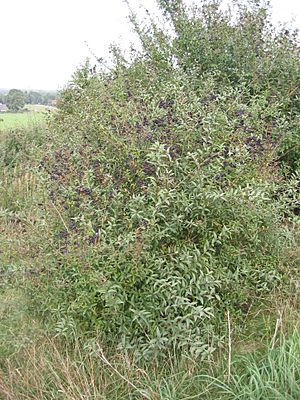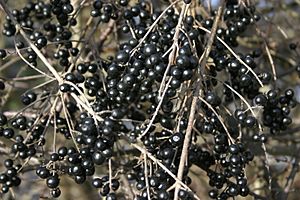Wild privet facts for kids
Quick facts for kids Wild privet |
|
|---|---|
 |
|
| Mature shrub in summer | |
| Scientific classification | |
| Genus: |
Ligustrum
|
| Species: |
vulgare
|
The wild privet (scientific name: Ligustrum vulgare), also sometimes called common privet or European privet, is a type of shrub. It grows naturally in many parts of central and southern Europe, northern Africa, and southwestern Asia. You can find it from Ireland and Sweden all the way south to Morocco, and east to Poland and Iran.
Contents
About the Wild Privet Plant
Wild privet is a shrub that can be either semi-evergreen (meaning it keeps some leaves in winter) or deciduous (meaning it loses all its leaves in winter). It usually grows up to 3 meters tall, but sometimes it can reach 5 meters. Its stems are strong and stand upright, with grey-brown bark that has small brown spots called lenticels.
The leaves grow in pairs directly opposite each other on the stem. They are shiny green, narrow, and oval-shaped, about 2–6 cm long and 0.5–1.5 cm wide.
Flowers and Berries
The flowers appear in mid-summer in clusters called panicles, which are about 3–6 cm long. Each flower is creamy-white and has a tube-like base with four small petals. These flowers have a strong smell that many people find unpleasant.
After the flowers, small, shiny black berries grow. Each berry is about 6–8 mm wide and holds one to four seeds. These berries are poisonous to humans, so you should never eat them. However, birds like thrushes enjoy eating them, which helps spread the seeds when the birds drop them.
Where Wild Privet Grows and How It's Used
In the British Isles, wild privet is the only type of privet that grows naturally. It is very common in hedges and woodlands in southern England and Wales, especially in areas with chalky soil. It is less common further north in England, Scotland, and Northern Ireland, where it mostly grows from seeds that have escaped from gardens.
This plant was used to make hedges in gardens in England during the time of Queen Elizabeth I. However, a different type of privet from Japan, called Ligustrum ovalifolium, became more popular because it stays green all year round.
Different Types of Wild Privet
Over time, people have chosen and grown different versions of wild privet, called cultivars, because of their special features. Here are a few examples:
- 'Aureum' – This type has yellow leaves.
- 'Buxifolium' – This one has small, oval leaves that are not longer than 2.5 cm.
- 'Cheyenne' – This type was chosen in North America because it can handle cold weather well.
- 'Chlorocarpum' – Its berries are green instead of black.
- 'Insulense' – This type has long, narrow leaves, about 5–11 cm long.
- 'Leucocarpum' – Its berries are greenish-white.
- 'Lodense' – This is a short and very bushy shrub. Its name comes from combining "low" and "dense."
- 'Pyramidale' – This one grows in a tall, narrow, pyramid shape.
- 'Xanthocarpum' – Its berries are yellow.
Wild Privet as an Invasive Plant
Sometimes, when a plant is brought to a new place where it doesn't naturally grow, it can spread very quickly and harm the local plants and animals. This is called being an invasive species. Wild privet is considered an invasive plant in countries like Australia, Canada, New Zealand, and the United States. It has also spread widely in the highlands of Mexico and in Argentina.
The Name of the Plant
The scientific name Ligustrum means ‘binder’. This name was given to the plant by ancient Roman writers like Pliny the Elder and Virgil.
Gallery
See also
 In Spanish: Ligustro común para niños
In Spanish: Ligustro común para niños







